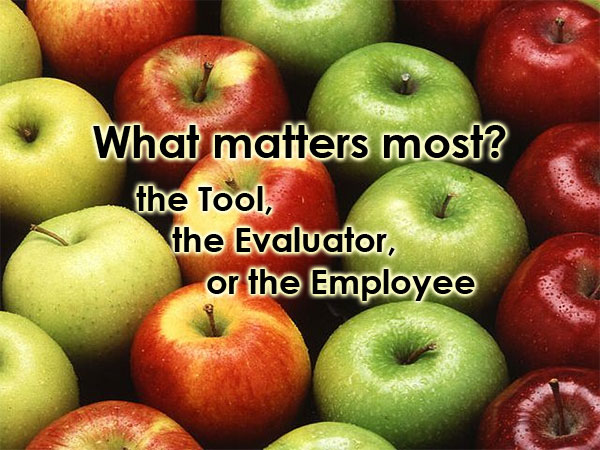Performance Appraisals: What Matters Most – the Tool, the Evaluator, or the Employee?
“Proper focus of performance appraisal is to change employees behavior on the job.”
Professor Angelo S. DeNisi, Dean of the A.B. Freeman School of Business at Tulane University, president of Society for Industrial and Organizational Psychology (SIOP)

http://en.wikipedia.org/wiki/File:Apples.jpg
As we approach the performance appraisal (PA) period, it is natural for evaluators as well as employees being evaluated to feel apprehensive. I would add a third group into this list: Human Resource professionals responsible for creating and implementing appraisal systems and processes. And to this group, I would ask: Have you done an effective job to support your peers in the organization? What can you improve on?
Mary-Anne (name changed) was hired as a Senior Talent Manager at a multinational corporation in the financial services industry. Her first assignment was to improve the appraisal system and processes. The company wanted to launch a new performance appraisal approach (to replace the old one) – to be based on new competencies and targets, one aligned with its new corporate strategy.
She first sought to understand the organization’s strategy. Mary-Anne also benchmarked the old PA system against other organizations’, and interviewed the senior management team to comprehend their expectations. With her findings on hand, she assembled a team of managers from different departments to develop the new competencies and the system. The senior management team was involved throughout the process. Six months later, the new PA was launched supported by communications and training for all employees. The senior team was pleased with the results of the launch and the employees understood the new system.
|
Reflection
|
So, what do you think, has Mary-Anne done an effective job?
To answer this question, it is indispensable for us to get to the core objective – what do companies want to achieve with a performance appraisal system? For example, making personnel decisions (such as promotion, salary, succession), identifying training needs, giving feedback to employees, etc.
I would argue that one of the main objectives of PA systems is to improve employees’ performance.
Years of progressive research on performance appraisal systems and processes have revealed:
1. Different systems (as tools), have little to no effect on the appraisal accuracy and evaluation error.
2. The thought processes of the evaluators, affected the quality of performance appraisals. Importantly, appraisal accuracy depends on the evaluators’ training, their method of recording observations throughout the year, etc.
3. The evaluated employees, are the most important piece of the PA process in changing employees behaviors and ultimately, increasing performance.
Additional research (on the efficacy and value of performance appraisals) also reveals that:
- Perception of fairness and justice has a positive impact on behavioral change;
- Furthermore, not every feedback intervention has a positive impact on performance. In fact, an extensive study from Kluger and DeNisi (1996) concluded that one third of the feedback interventions have negative or no effect on performance.
With all these research in the palm of your hands, did Mary-Anne perform well for her assignment? Yes, but.
Mary-Anne focused significantly on developing the system, onboarding and training the evaluators to utilize its functionality. And she has definitely done outstandingly in many aspects: benchmarking other organizations, involving the management team, understanding the company’s strategy, investing in communication and training, etc. However she did not emphasize enough effort to help the evaluated employees improve (a critical aspect of the appraisal process). She could give more attention to ensure that the new appraisal system would increase employee performance.
Actions:
Here are three areas of actions/activities you (and Mary-Anne) can improve in your Performance Appraisal plan:
1. Increase feedback efficacy and value – training, coaching and other relational actions ensure that feedback provided by the evaluator will be effective (e.g., is specific, contains suggested solution, balances negative and positive feedback, considers individual differences).
2. Increase perceptions of fairness and integrity – ensure that the employee being evaluated has a voice and participates in the PA process. Use more than one evaluator to minimize biases or personality judgments.
3. Ensure linkage with other Talent Management (TM) arrangements – it is also necessary to link the performance appraisal approach with other TM arrangements such as competency training, career mentoring, succession planning, etc.
Our people matter more than the system!
Wish you all a great job with your Performance Appraisals!
- Be One Step Ahead, Grow Your Future Performance. - May 13, 2014
- Performance Appraisals: What Matters Most – the Tool, the Evaluator, or the Employee? - February 11, 2014





